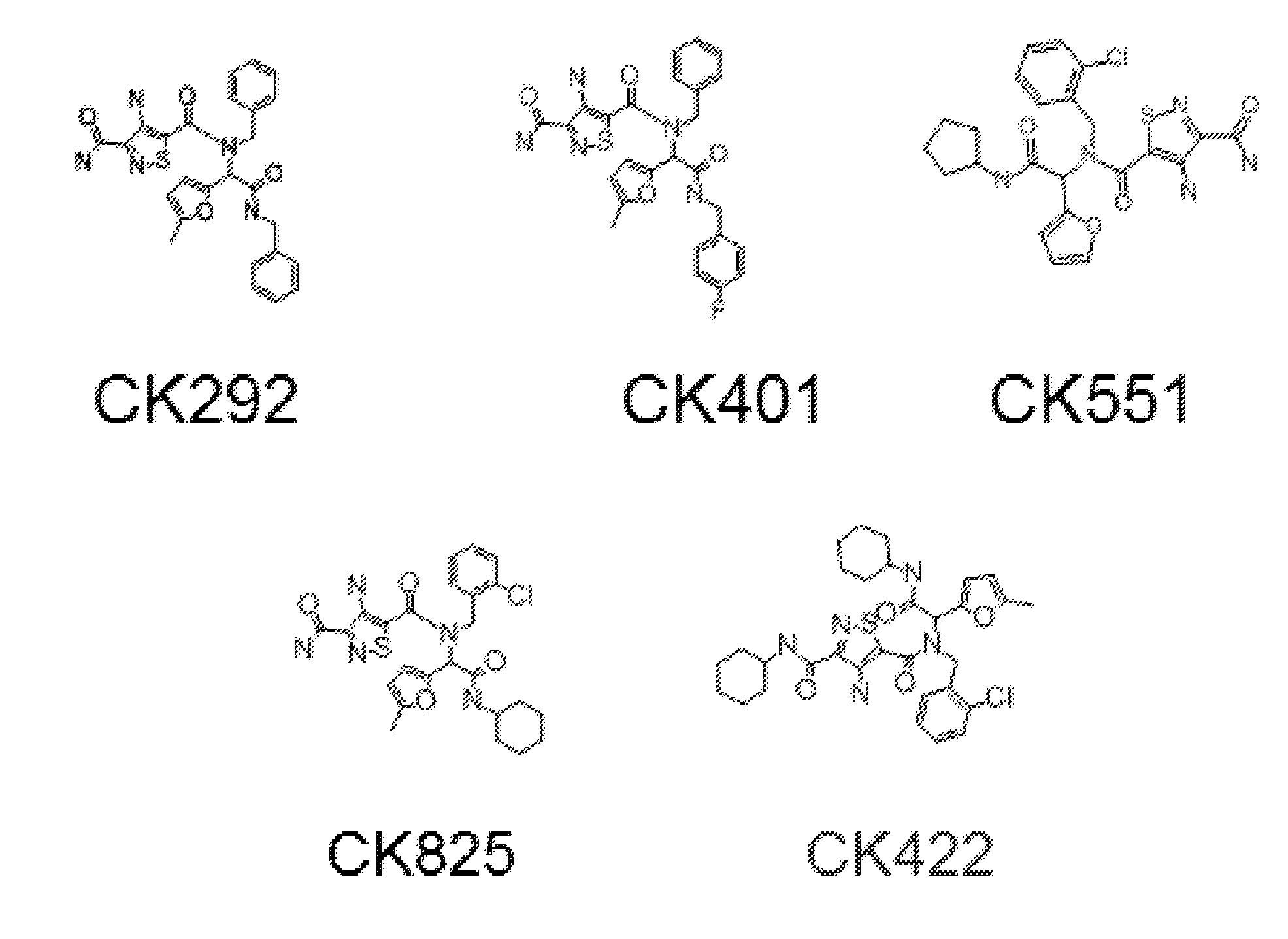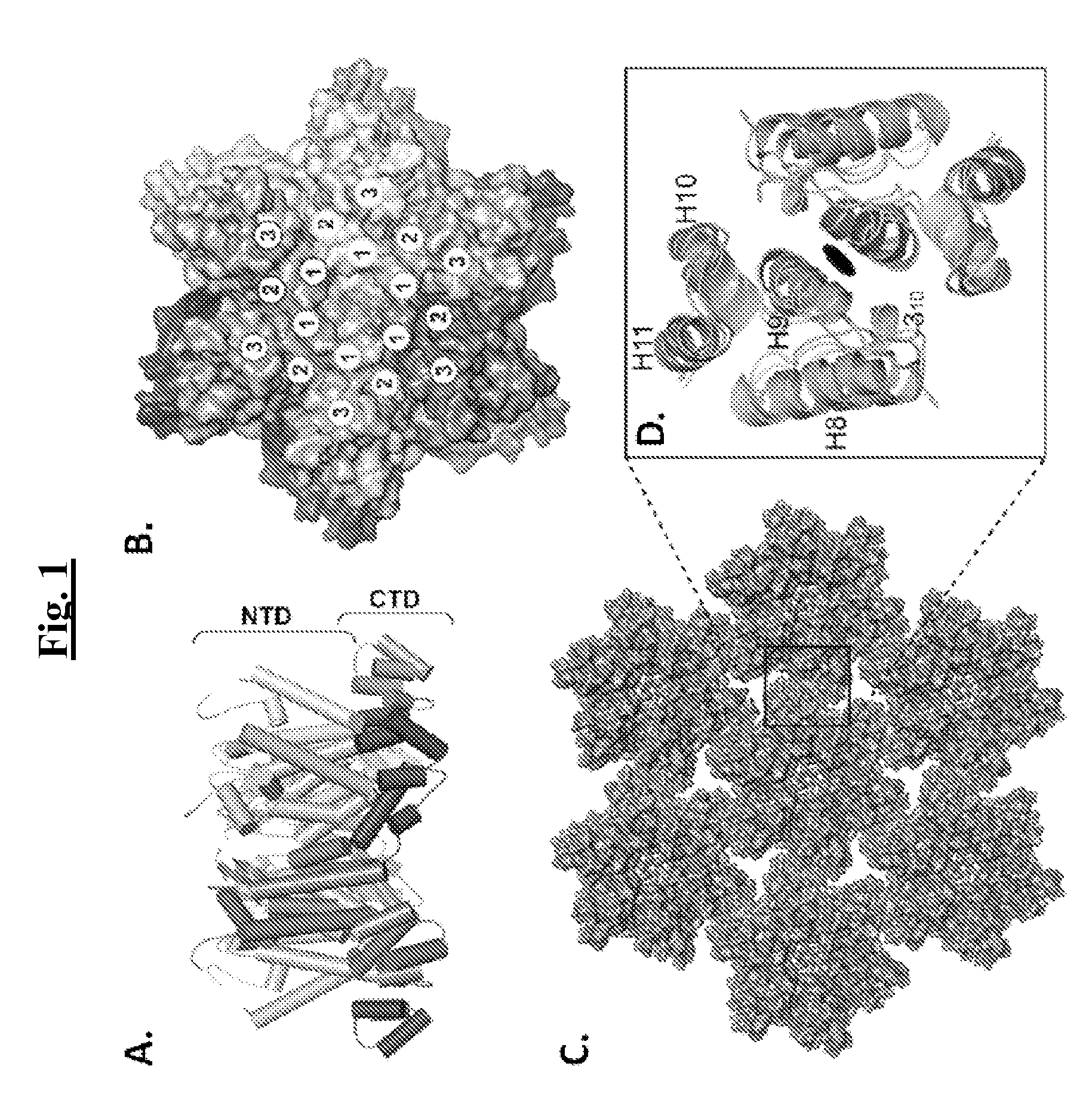Small Molecule Modulators of HIV-1 Capsid Stability and Methods Thereof
a small molecule modulator and stability technology, applied in the field of small molecule modulators of hiv-1 capsid stability, can solve the problems of affecting the fitness of the virus, dhf is a potentially lethal complication, fever, vomiting, bleeding, etc., and achieves the effect of inhibiting, suppressing or preventing a viral infection in a subj
- Summary
- Abstract
- Description
- Claims
- Application Information
AI Technical Summary
Benefits of technology
Problems solved by technology
Method used
Image
Examples
example 1
Screening of a Novel Enriched Database of Small Molecules Using the HSB Method and the Structure of the HIV-1 CA Protein
[0317]An iterative in silico-in vitro method called the hybrid structure-based (HSB) method was used for screening small molecules to inhibit the CA NTD-NTD interface. The initial HSB protocol for designing small-molecule inhibitors to G-protein coupled receptors has been described in detail by Kortagere and Welsh (Kortagere et al., 2006, J. Comput. Aided Mol. Des. 20:789-802). The HSB method was recently customized to design protein-protein interaction inhibitors of Plasmodium falciparum (Bergman et al., 2007, “Small Molecule Inhibitors of the P. falciparum MyoA Tail-MTIP Intercation”, Molecular Parasitology meeting XVIII, MBL, Woods Hole; Kortagere et al., 2010, J. Chem. Inf. Model. 50:840-49). The protocol consists of multiple phases that are used in an iterative manner.
[0318]A comprehensive electronic database of commercially available small molecules was devel...
example 2
Identification of CMPD-A as an Early-Stage Inhibitor of HIV-1 Replication
[0322]The HSB method (Kortagere et al., 2009, Pharm. Res. 26:1001-11; Kortagere et al., 2010, Environ. Health Perspect. 118(10):1412-17; Kortagere et al., 2006, J. Comput. Aided Mol. Des. 20:789-802; Kortagere et al., 2010, J. Chem. Inf. Model 50:840-49 and Peng et al., 2009, Bioorg. Med. Chem. 17:6442-50) was used to design small-molecule inhibitors targeted to the NTD-NTD hexameric interface of HIV-1 CA. The HSB method, as the name implies, is a hybrid method combining elements of ligand-based and structure-based virtual screening strategies: using ligand-based methods to build enriched libraries of small molecules, and then employing a combined receptor-ligand pharmacophore to screen molecules from the enriched library and to further dock the molecules to their receptor. The docked complexes are then scored based on a number of physicochemical parameters to indicate high-ranking molecules. The results of thi...
example 3
Size Reduction and Optimization of CMPD-A: Identification of CMPD-E
[0324]Compound CMPD-A displayed activity in single- and multiple-round infection assays using cell lines, but was unable to inhibit the primary isolate HIV-192BR030 replicating in PBMCs. This compound probably suffered from poor permeability across the PBMC membrane. This is probably a function of its poor drug like properties (high octonol water partition co-efficient (logP) of 9.31 as determined using the weighted logP function in JChem) and large molecular weight (692 Da). As such, attempts were made to reduce the size of the compound and optimize its physical-chemical properties, as to improve its PBMC permeability, while retaining its antiviral activity. CMPD-A has a C2 symmetry along the central dibenzofuran ring and docking results suggested that the proposed binding area of CMPD-A spans the entire NTD dimer interface including the junction between the N and C-terminal lobes (FIGS. 8A and 8B).
[0325]Based on th...
PUM
| Property | Measurement | Unit |
|---|---|---|
| Molar density | aaaaa | aaaaa |
| Pharmaceutically acceptable | aaaaa | aaaaa |
| Stability | aaaaa | aaaaa |
Abstract
Description
Claims
Application Information
 Login to View More
Login to View More - R&D
- Intellectual Property
- Life Sciences
- Materials
- Tech Scout
- Unparalleled Data Quality
- Higher Quality Content
- 60% Fewer Hallucinations
Browse by: Latest US Patents, China's latest patents, Technical Efficacy Thesaurus, Application Domain, Technology Topic, Popular Technical Reports.
© 2025 PatSnap. All rights reserved.Legal|Privacy policy|Modern Slavery Act Transparency Statement|Sitemap|About US| Contact US: help@patsnap.com



